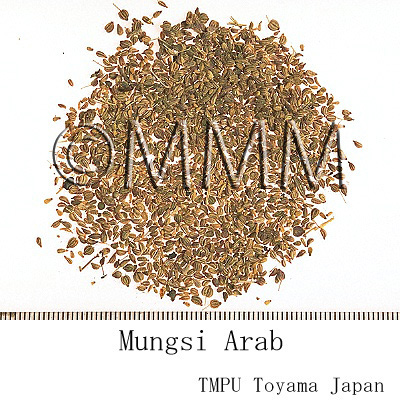Crude drug sample data base
※Click on the image to enlarge it.
Scientific information data base
| Crude drug name | Indonesian name, English name | Mungsi (Carum copticum) | ||||
|---|---|---|---|---|---|---|
| crude drug image |
| |||||
| Original plant name | Carum copticum Benth. & Hook. f. | |||||
| Family name | Umbelliferae | |||||
| Used part | Fruits | |||||
| Distribution area | It is cultivated in Java [201]. | |||||
| Description | Annual growing to 0.6m by 0.4m with white flower. | |||||
| Specific actions | Carminative, stimulant, antispasmodic, antiseptic. | |||||
| Frequency in use | Frequent | |||||
| Pharmacological effect | Result of a study indicated a competitive antagonism effect of Carum copticum at histamine H1 receptor. A beta adrenergic stimulatory effect of essential oil and an anti-cholinergic property of the plant were also suggested. A study on the analgesic effect of Carum copticum extract and morphine on phasic in mice indicated that the extract reveals antinociceptive action which may be of the opioid type. The study on the antihypertensive, antispasmodic, bronchodilator and hepatoprotective activities on the Carum copticum seed extract is aimed at rationalizing some of its traditional uses. The result indicated the presence of calcium antagonist (s) in the seeds which provides sound mechanistic basis for some of their folklore uses [PMID: 15763373]. Antitussive effect of Carum copticum in guinea pigs showed significant reduction of cough number obtained in the presence of aqueous and macerated extracts and codeine. It also indicated an antitussive effect of Carum copticum which was even greater than that of codeine at concentration used. In addition, the antitussive effect was not due to its main constituent, carvacrol [PMID: 15652279]. Fraction 2 and 3 of the essential oil from Carum copticum showed potent and volume (concentration) dependent relaxant effects comparable to theophylline. The results indicate that the relaxant effect of essential oil from Carum copticum is mainly due to its fraction 2 which is presumably carvacrol and to lesser extent due to fraction 3. Their relaxant effects are not due to anticholinergic or beta-adrenergic stimulatory effects [PMID: 14669246]. Total alcoholic extract and total aqueous extract of the seeds of Carum copticum exhibited significant anti-inflammatory potential [231]. | |||||
| Medical system | Indonesian medicine (Jamu) | |||||
| Traditional usage | It is used as an ingredient in some formulas to induce menstruation and after childbirth to purify uterus and stop bleeding. It expels wind and thus can be used to treat flatulence and other stomach problems. In Java it is pounded and mixed with water, strain and used for stomach disorders (abdominal pain, flatulence). For that purpose, sometimes one or two teaspoons of powdered fruit are put in one cup of water [201]. | |||||
| Formulation | 1) Indigestion and digestive debility: 15 grams of powdered fruits are poured in 350 grams of boiling water and stand to cool. Strain and drink one glass of the infusion 4 times a day. (one glass is measured as a wine glass) [217]. 2) Dysentery: 1 teaspoon of fruits of C. copticum, 1 teaspoon of fruits of Coriandrum sativum, 3 tablespoons of red rice. Stir-fried all ingredients and powdered. Drink the infusion of the powder as a tea. | |||||
| References | Reference book Tips! | [201] K. Heyne, Tumbuhan Berguna Indonesia, Vols. 1-4, 1987. Diedarkan Oleh Koperasi Karyawan Departemen Kehutanan, Jakarta, Indonesia. Vol. 3, p 1549. [217] A. seno Sastroamidjojo and A. Tjokronegoro: Obat asli Indonesia (Indonesian original medicine). Dian Rakyat, Jakarta, Indonesia, 1997. p 190. [222] P.T. Eisai Indonesia: Medical Herb Index in Indonesia (Second edition).1995. p 181. [231] Soedibyo, Mooryati: Alam Sumber Kesehatan: Manfaat dan Kegunaan (Natural resources for health. Benefits and uses). Balai Pustaka. 1998. pp 267-268. | ||||
| Research paper | 1. Gilani AH, Jabeen Q, Ghayur MN, Janbaz KH, Akhtar MS. Studies on the antihypertensive, antispasmodic, bronchodilator and hepatoprotective activities of the Carum copticum seed extract. J. Ethnopharmacol., 8;98(1-2):127-35, 2005. (PMID: 15763373) 2. Boskabady MH, Jandaghi P, Kiani S, Hasanzadeh L. Antitussive effect of Carum copticum in guinea pigs. J. Ethnopharmacol., 10;97(1):79-82, 2005. (PMID: 15652279) 3. Boskabady MH, Ramazani M, Tabei T. Relaxant effects of different fractions of essential oil from Carum copticum on guinea pig tracheal chains. Phytother. Res., 17(10):1145-9, 2003. (PMID: 14669246) 4. C. Thangam and R. Dhananjayan: Antiinflammatory potential of the seeds of Carum copticum Linn. Indian J. Pharm., 35(6): 388-391, 2003. | |||||
| Last renewal date | 2024/03/12 | |||||







